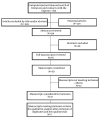Efficacy of epidural injections in the treatment of lumbar central spinal stenosis: a systematic review
- PMID: 25789241
- PMCID: PMC4350165
- DOI: 10.5812/aapm.23139
Efficacy of epidural injections in the treatment of lumbar central spinal stenosis: a systematic review
Abstract
Context: Lumbar central spinal stenosis is common and often results in chronic persistent pain and disability, which can lead to multiple interventions. After the failure of conservative treatment, either surgical or nonsurgical modalities such as epidural injections are contemplated in the management of lumbar spinal stenosis.
Evidence acquisition: Recent randomized trials, systematic reviews and guidelines have reached varying conclusions about the efficacy of epidural injections in the management of central lumbar spinal stenosis. The aim of this systematic review was to determine the efficacy of all three anatomical epidural injection approaches (caudal, interlaminar, and transforaminal) in the treatment of lumbar central spinal stenosis. A systematic review was performed on randomized trials published from 1966 to July 2014 of all types of epidural injections used in the management of lumbar central spinal stenosis. Methodological quality assessment and grading of the evidence was performed.
Results: The evidence in managing lumbar spinal stenosis is Level II for long-term improvement for caudal and lumbar interlaminar epidural injections. For transforaminal epidural injections, the evidence is Level III for short-term improvement only. The interlaminar approach appears to be superior to the caudal approach and the caudal approach appears to be superior to the transforaminal one.
Conclusions: The available evidence suggests that epidural injections with local anesthetic alone or with local anesthetic with steroids offer short- and long-term relief of low back and lower extremity pain for patients with lumbar central spinal stenosis. However, the evidence is Level II for the long-term efficacy of caudal and interlaminar epidural injections, whereas it is Level III for short-term improvement only with transforaminal epidural injections.
Keywords: Injections; Pain; local Anesthetic.
Figures
References
-
- Hall S, Bartleson JD, Onofrio BM, Baker HL, Jr., Okazaki H, O'Duffy JD. Lumbar spinal stenosis. Clinical features, diagnostic procedures, and results of surgical treatment in 68 patients. Ann Intern Med. 1985;103(2):271–5. - PubMed
Publication types
LinkOut - more resources
Full Text Sources
Other Literature Sources

